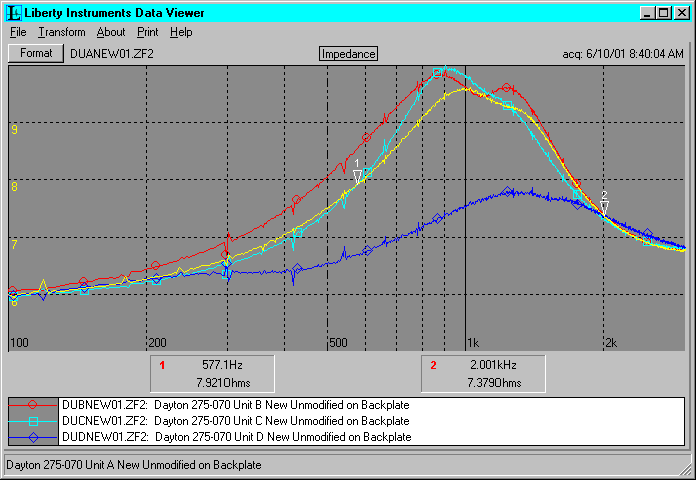The first thing to do was measure the impedance. I measured the DC resistance with a Fluke multi-meter which showed 3 samples to be 5.8 ohms and one to be 5.6 ohms. Right away I knew something was amiss. Drivers generally have identical measurements of DC resistance for the same model. I know that I'll need to look more closely to see what's different with the odd sample.
Next I measured the impedance of each unit using LAUD. This confirmed the low resistance of the odd sample. A bit of variation between all of the units also became apparent. Two of them are fairly close, a third runs a bit high, and the fourth, the odd unit, is very far off from the others. This is shown in the two graphs* below.
* The spikes at marker 2 are due to noise in my test setup (as well as several of the others higher in frequency). It's picking up a 60hz line hum, so they can be ignored. I've had to move my test system and will have to re-arrange to reduce this. The other small spikes seen are also not artifacts of the drivers themselves.
 |
The second graph below is an expanded version of the one above, to provide more detail.
 |
The drivers are supposed to have an Fs of about 900hz. Unit C looks like it is spot on. Unit B looks to be close, but has some significant variation around it. Unit A looks to be around 1khz. Unit D (the one which measured low for resistance) has a serious problem. All of them have a similiar double-humped impedance as exhibited by Morel drivers.
0 They re-converge at 2khz. The first three units have nearly identical magnitude rise characteristics above this. Unit D again diverges seriously from the others, pointing to some significant problem with it. I will hazard a guess that there is a coil problem of some sort with Unit D. The differences in the others should be due to dome material and/or ferrofluid. One other possiblity I'll check is the location of the felt beneath the dome. It's possible to see through the dome to some degree. On one sample the felt is obviously slightly off-center, which could place it in contact with the dome as well as slightly affect any resonances due to the vent (a pipe in essence).
My next step is to mount them and make some raw SPL measurements before I open them up. I hope to accomplish two things. First, find out why there is any variation between the units. Second, to see if any improvements can be made. I'm sure that the Fs can be lowered. I also hope that any variation in the SPL response can be corrected, at least partially (since there is a limit as to what one can do with any tweeter).